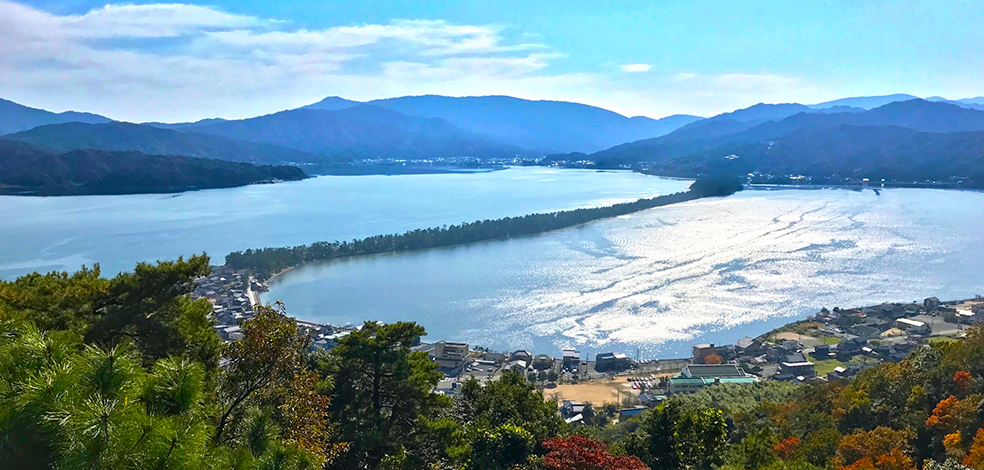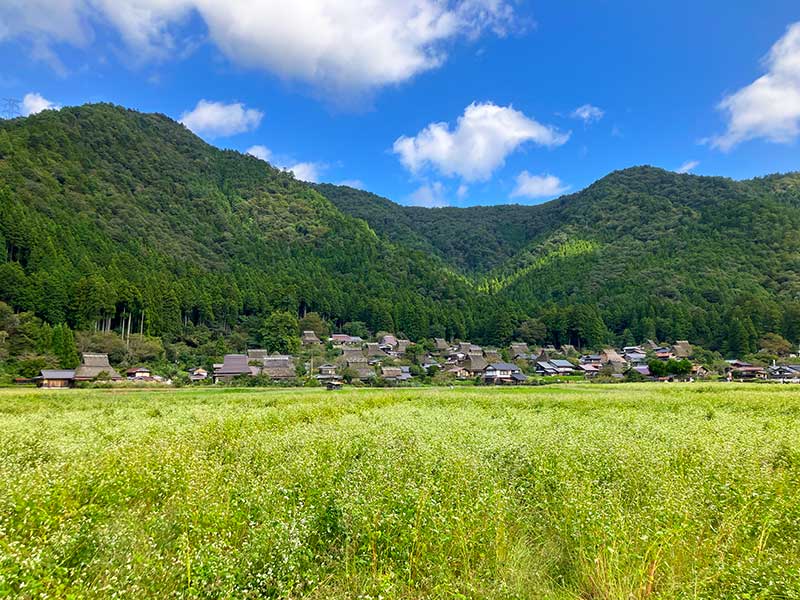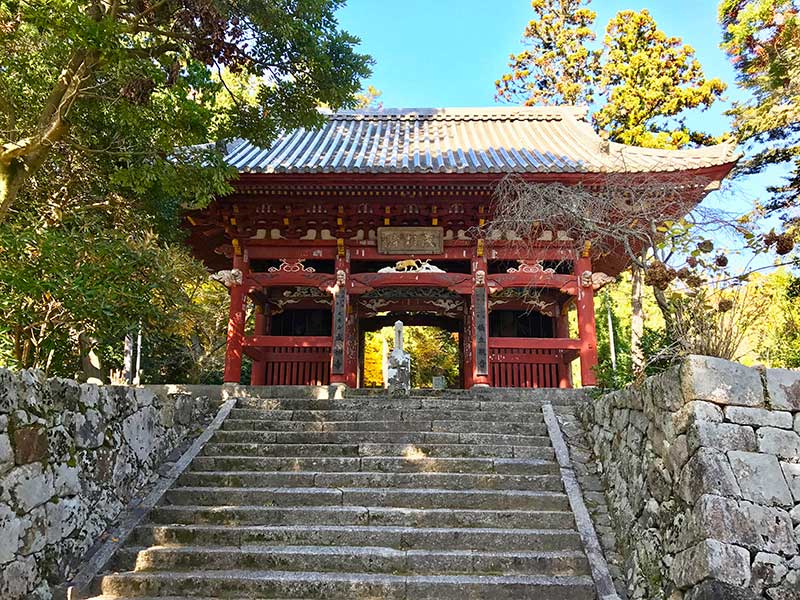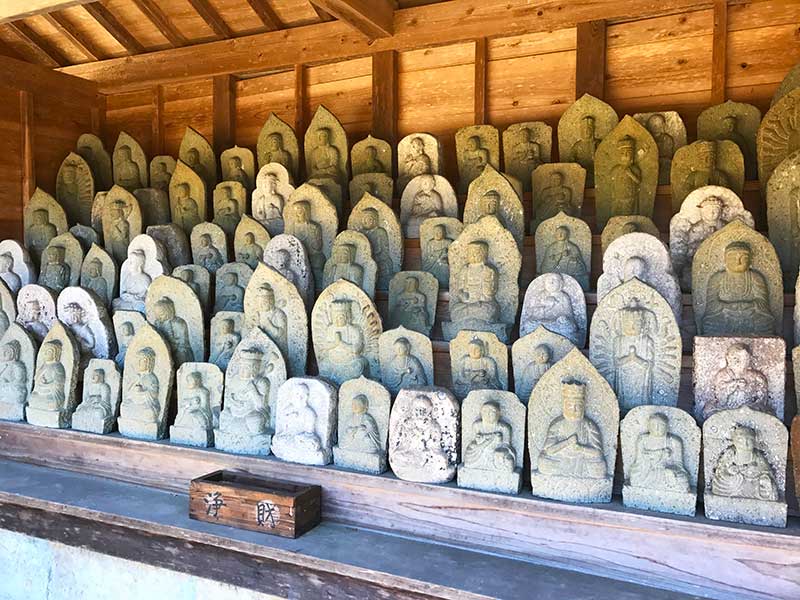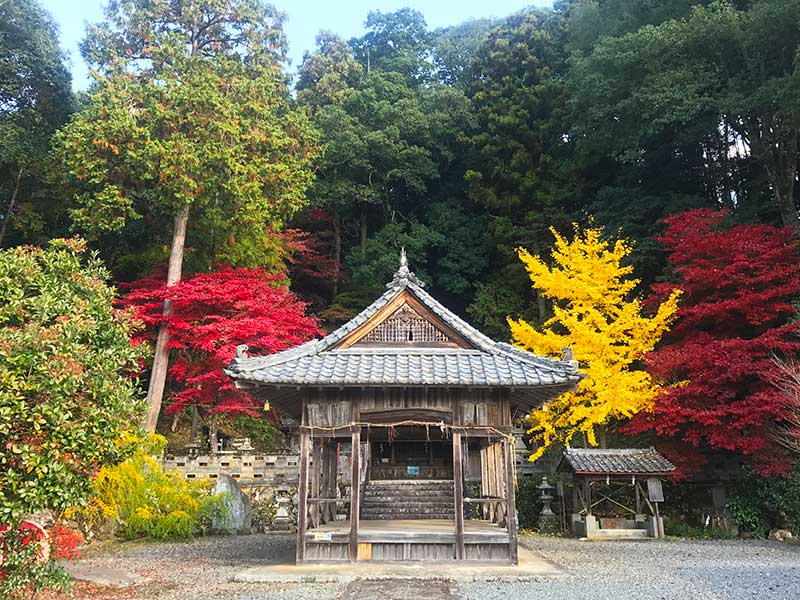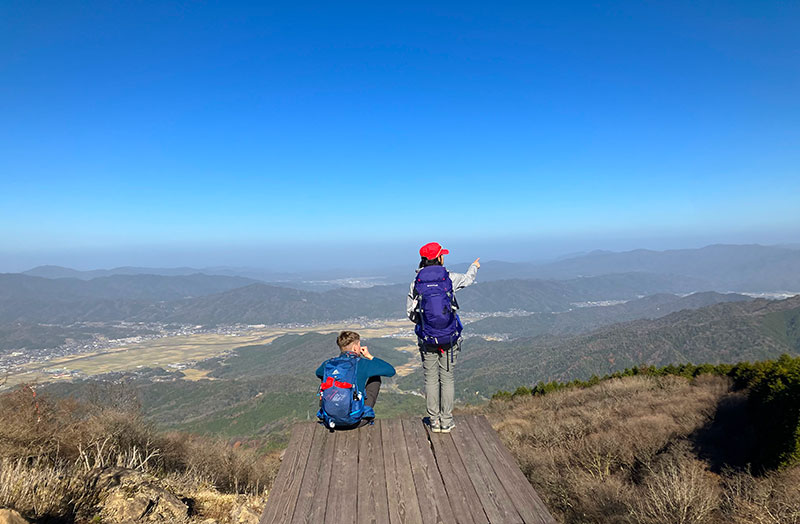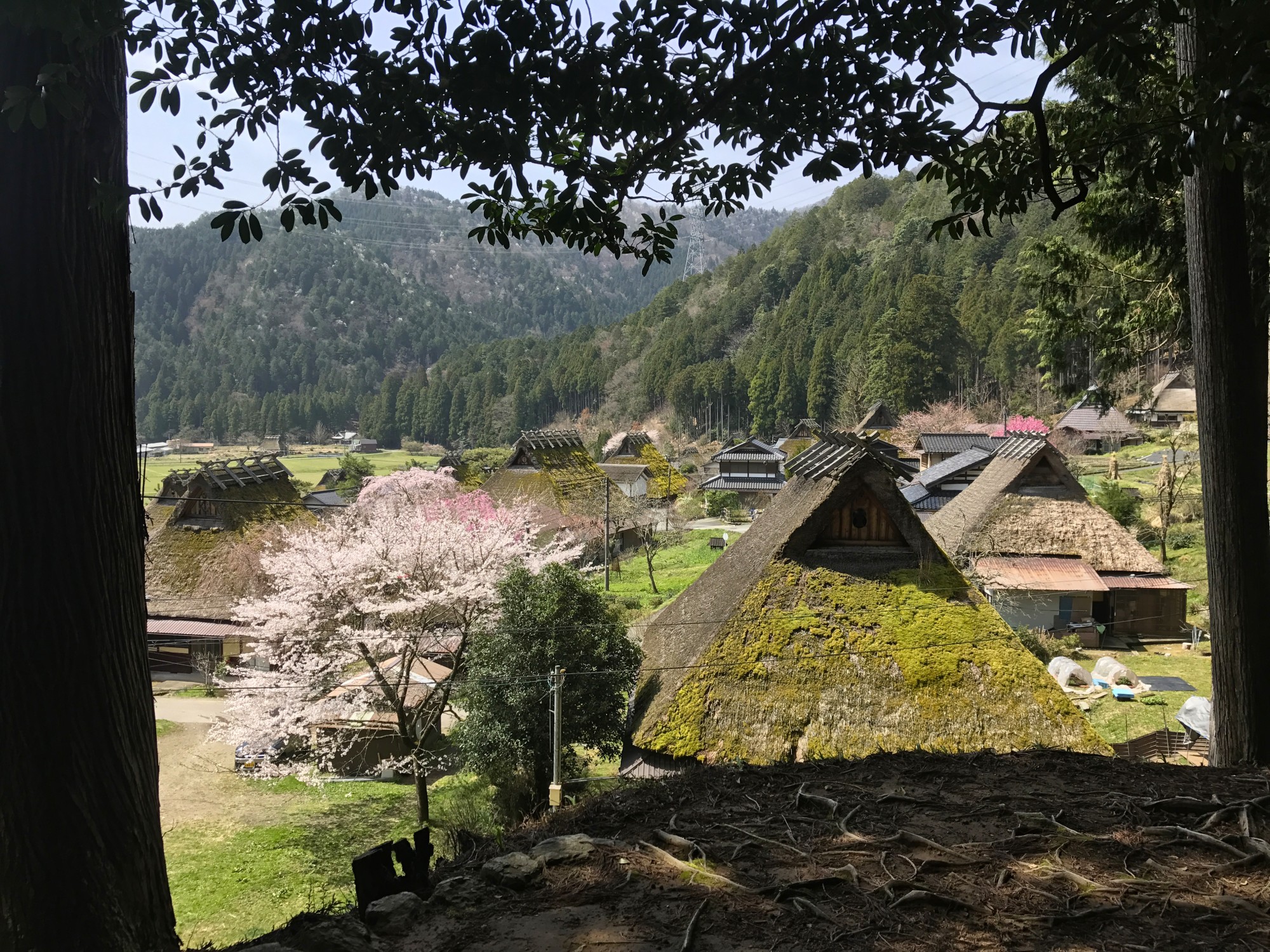A moderate to harder walking tour along ancient thoroughfares from Kyoto to the Sea of Japan coast.
A guided exploration of the remote and beautiful countryside of Kyoto mountainous hinterland along ancient trade routes to the Amanohashidate and the Sea of Japan; great walking and hiking through rural and mountainous countryside trails; traditional and modern inns, hearty farmhouse cuisine.
March - June & September - November.
A 7-day, 6-night tour starting in Kyoto and finishing in Amanohashidate. Tour accommodation is in hotels and Japanese inns. Please read more on accommodation here. The maximum group size for this tour is 12 persons. We have no minimum size. If we accept a booking we guarantee to run the tour.
Beyond Kyoto, Japan’s 1,000 year-old imperial capital, religious and cultural cradle, is another Kyoto, an idyllic rural region of mountains and valleys, forests and farming villages, remote hillside hamlets and fishing ports on the Sea of Japan coast. The contrast between the bustling city and its bucolic hinterland could not be more stark. Yet the two have an intimate symbiotic relationship, established over a millennia, that thrives to this day.
Trains heading north quickly journey through a series of tunnels and across a river gorge to be surrounded by rice paddies on all sides. Beyond, lies a vast hinterland. Here, the Kyoto of mountains ranges seemingly endlessly, cupping myriad valleys where the early morning clouds allude to what lies far beyond, the Kyoto of the sea. It is a diversely plentiful region of a multitude of districts, usually delineated into small valley communities, each with their own distinct identities and unique produce. Those who live here pride themselves on both their alliance but also clear contrast with the city that is so saliently important to the Japanese identity. The Japanese imperial court moved to Heian-kyo, modern-day Kyoto, in 794. Ever since, the many small rural communities to the north have been the source of much of the city’s signature produce including high-quality food, timber, charcoal, washi paper, pottery, and takezaiku bamboo arts. To sustain this trade, a multitude of paths weave their way throughout the region connecting the sea and mountain communities with the city. Mostly forgotten in the modern era, these ancient byways are the focus of our exploration, which connects us with the people and culture of Kyoto’s fascinating hinterland, its history, and its intimate relationship with the city that began with its aristocratic and religious elites.
We explore paths, some known only by locals, that often follow mountain ridges, which once provided the fastest and safest means of transport of goods to the city and communications vital between local communities. En route, we pass through hidden valleys and quiet villages with their traditional thatched buildings retaining an air of a much older age, and come across venerable chestnut trees that have been the source of sustenance for villagers over centuries. We also learn of fables of old that include battles between oni ogres and imperial warriors; a Buddhist nun cursed for 800 years to traverse the country with a statue tied to her back; and the goddess of agriculture Toyouke Omikami. Our journey culminates at the coast and the Amanohashidate heavenly bridge sandbar, one of Japan’s three scenic views.
Kyoto’s mountains and sea have long been the city’s breadbasket and we each day on our travels we enjoy some of the region’s best produce including Miyama ayu sweetfish, Tanba buri yellowtail and saba mackerel, and a wide variety of Kyoyasai heirloom vegetables. Our accommodation is mostly family-run, small traditional inns, some with onsen hot spring baths.
A Level 4 tour that includes undulating forest terrain and climbs over several low passes, some with short but steep inclines. Our main baggage is sent onwards each morning to our evening’s accommodation so we only need to take what is necessary for the day’s walking in a small backpack.
We meet in Kyoto and travel together through the remote countryside of its hinterland to Amanohashidate, our destination on the Sea of Japan coast. Walk Japan provides tour participants with easily followed, detailed instructions on how to join the tour.

Day 1 Kyoto - Hiyoshi
Your Walk Japan Tour Leader welcomes you to the tour mid-morning at Kyoto Station. Our venture into the verdant mountainous heart of Kyoto Prefecture begins here aboard a train.
The cityscape is soon behind us as we wend north finally alighting at a quiet station serving a small rural community. From here a vehicle transfers us to our accommodation, a Japanese inn with onsen hot spring baths set in beautiful surroundings beside a crystal-clear river.
After lunch here we enjoy our first walk of the tour following quiet paths, that weave their way aside a river, through forests and skirt rice paddies and fields of susuki grass and yoshi reed. Eventually, we reach a charming village of traditional buildings thatched with the susuki and yoshi we saw earlier. The largest of these lovely structures is over 225 years-old and the home of an artisanal indigo workshop and gallery.
We explore this picturesque village at a leisurely pace, before returning to our inn. A relaxing soak in the onsen baths is followed by dinner, a delicious feast composed of seasonal ingredients sourced from the local area.
Accommodation: Japanese inn with onsen hot spring baths.
Meals: Dinner provided.
Total walking: 6.58km (4.1 miles).
Total elevation gain: 70m (230ft).
Day 2 Hiyoshi - Miyama
After breakfast, we transfer by vehicle to a hamlet deep in the mountains at a point roughly equidistant from Kyoto City and the Sea of Japan. Our walk begins with a visit to a local shrine, before we climb steadily through forests. Locals, porters and beasts of burden once trod this path with heavy loads of charcoal, preserved seafood and processed timber. However, fellow travellers are now few and far between and we are unlikely to meet anyone else on the trail today.
We soon reach an atmospheric temple. Established in the 10th Century it was constructed around a giant boulder that has long been considered sacred. The temple is associated with the legend of an 800 year-old itinerant Buddhist nun. Apparently, she once rested here on her never ending journey and left behind the statue of Jizo, a Buddhist deity that protects travellers, found atop the boulder.
We enjoy a bento picnic lunch here before winding our way down through forests to a quiet hamlet of thatched houses. Beyond, our path takes us up a short but steep climb to the top of a ridge, where we find the remains of an ancient castle. From here we enjoy wonderful views over the valley below.
A descent through a forest brings us to the valley floor from where a vehicle whisks us to our accommodation, an inn on the outskirts of a quiet hamlet. The warm welcome shown by our hosts is quickly followed by a well-earned soak in onsen baths. Our dinner is a feast of local dishes prepared by our friendly hosts.
Accommodation: Traditional Japanese inn with onsen hot spring baths.
Meals: Breakfast, lunch & dinner provided.
Total walking: 16.2km (10.1 miles).
Total elevation gain: 520m (1706ft).
Day 3 Miyama - Fukuchiyama
After enjoying breakfast, we transfer by vehicle to the start of today’s walk in native woodlands. Once again, we follow our way up and over a pass on a trail that once was a busy thoroughfare but today is almost wholly unused. Beyond the pass we reach a stand of centuries-old native horse chestnut trees.
Finally, we arrive at a quiet hamlet that used to thrive in the Edo Period (1603-1868). Today, however, only two women in their 90s and a man in his 60s are resident. Deep in the mountains and far from good arable land and the sea, horse chestnuts were once a vital source of sustenance for the locals. Now they are only used in tochi-mochi rice cake, a tasty delicacy handmade by the villagers.
After sampling some morsels, a vehicle takes us via a tranquil temple to Fuchiyama and our accommodation, a hotel with onsen baths, for the evening. Tonight, we venture into town to enjoy dinner at a popular local restaurant.
Accommodation: Western-style hotel with onsen hot spring baths.
Meals: Breakfast, lunch & dinner provided.
Total walking: 9.6km (6 miles).
Total elevation gain: 668m (2,191ft).
Day 4 Fukuchiyama - Oe
After breakfast, a private vehicle takes us to the outer Moto-Ise shrine, the first of three Moto-Ise shrines inextricably linked with the Ise Grand Shrine. Ise enshrines Amaterasu-Omikami, the celestial sun goddess from which the Japanese imperial family claims descent, making it one of Shinto’s most important holy sites. Legend relates that the Moto-Ise shrines predate the foundation of Ise Grand Shrine itself and that it was here Amaterasu was originally enshrined.
An ancient trail leads from the Moto-Ise’s outer to its atmospheric inner shrine. We rest over lunch in a quiet hamlet before continuing on our way up a gentle climb aside a tumbling river. Local fables relate that the massive rocks in the riverbed were flung here by oni ogres from the surrounding mountaintops to dissuade any visitors. Unfazed by these legends, our trail continues over an ancient ishidatami stone path that leads us to our accommodation, a modern lodge. We once again repeat the evening’s pleasurable routine of soaking in baths and then enjoying a delicious dinner composed of local ingredients.
Accommodation: Modern lodge.
Meals: Breakfast, lunch & dinner provided.
Total walking: 14km (8.7 miles).
Total elevation gain: 416m (1365ft).
Day 5 Oe - Yosano
This morning we visit the local oni museum before a vehicle takes us to the beginning of our walk at a small shrine perched high in the mountains. On a good weather day, from here we are afforded tremendous views across the surrounding mountains that extend unbroken into the distance.
We spend the day traversing the Oe mountain range's three main peaks: Mt. Senjugatake (833m), Mt. Hatogamine (736m) and Mt. Nabekura (763m). To sustain our efforts we are served an oni-themed bento lunch at another scenic viewing point, before descending to an inn, our accommodation for the evening. Our host provides a lively and entertaining atmosphere over a dinner of culinary delights that draws heavily on his previous experience as a chef in Osaka.
Accommodation: Traditional Japanese inn.
Meals: Breakfast, lunch & dinner provided.
Total walking: 9.1km (5.6 miles).
Total elevation gain: 389m (1,276ft).
Day 6 Yosano - Miyazu
A relaxed breakfast at the inn is followed by another day walking through beautiful mountainous terrain largely following the Miyazu Kaido. This is an ancient highway that was used from the 10th Century until the early modern age as a trade route and for sankin-kotai, the system of alternative residence by regional daimyo lords to attend the shogun in Edo; today’s capital Tokyo. Ishidatami stone-paved sections are reminders of the trail’s history as we thread our way through forests, crossing numerous mountain streams before eventually reaching a high pass. We stop here to relax, enjoy a bento lunch and the far reaching views to the Sea of Japan.
As we follow a forested trail down to the valley below we pass a small temple that is said to be the final resting place of Akechi Mitsuhide, a 16th Century samurai notorious in Japan as the traitorous assassin of Oda Nobunaga, who is regarded as the first ‘Great Unifier’ of Japan who was followed in succession by Toyotomi Hideyoshi and finally Tokugawa Ieyasu.
We board a local train for a short journey to Miyazu, a small port town on the Sea of Japan coast and our accommodation, a delightful Japanese inn that has been in business for over 320 years. Our host, the 13th generation innkeeper, happily introduces its architecture, intricately painted fusuma sliding doors, poetic calligraphy and letters lining the walls from famous Japanese writers and artists who have stayed here over the years.
Relax here in these beautiful surroundings or join your Tour Leader on an amble around Miyazu until dinner, our final evening feast of the tour.
Accommodation: Traditional Japanese inn.
Meals: Breakfast, lunch & dinner provided.
Total walking: 11km (6.8 miles).
Total elevation gain: 312m (1,024ft).
Day 7 Miyazu - Amanohashidate
After enjoying breakfast, we take a short train ride to Amanohashidate, which translates as Heaven’s Bridge, a pine tree-covered sandbar considered one of Japan's three most scenic views. Amanohasidate stretches for 3.3 kilometres and connects the two opposing sides of Miyazu Bay. We walk across it through the pine trees to the Moto-Ise Kono shrine, the third of the Moto-Ise shrines we first came across on Day 4.
From here, we make a short climb up a mountain path up to the impressive Nariai-ji, the 28th temple of the 33 associated with the Saigoku Kannon Pilgrimage that extends throughout the wider region here. We walk through the temple’s attractive grounds, passing a towering pagoda to reach a classic viewing point of Amanohashidate and the Sea of Japan beyond.
We board a small ferry to reverse our journey across the bay to the railway station, where our tour ends around mid-afternoon. Onward travel from here is best made by express train back to Kyoto or Osaka for destinations further afield. Your Tour Leader will be available to advise on the purchase of tickets as required.
Accommodation: N/A.
Meals: Breakfast provided.
Total walking: 9.4km (5.8 miles).
Total elevation gain: 349m (1145ft).
This itinerary is subject to change.
The airport closest to the tour's start at Kyoto is Osaka’s Kansai International Airport. Transfer is also easily made from both Tokyo’s Narita and Haneda International Airports.
-----
FROM OSAKA’S KANSAI INTERNATIONAL AIRPORT (KIX)
From Osaka’s Kansai International Airport, Haruka Express trains depart to Kyoto Station, where the train terminates. The journey costs about JPY3,290 per person and takes approximately 1 hour 15 minutes.
-----
FROM TOKYO’S HANEDA AIRPORT (HND)
From Tokyo’s Haneda International Airport, Keikyu Line trains depart to Shinagawa Station, where shinkansen bullet trains then depart for Kyoto. The journey costs about JPY13,900 per person and takes approximately 3 hours 10 minutes.
-----
FROM TOKYO’S NARITA AIRPORT (NRT)
From Tokyo’s Narita International Airport, Narita Express trains depart to Tokyo Station, where shinkansen bullet trains then depart for Kyoto. The journey costs about JPY16,240 per person and takes approximately 3 hours 30 minutes.
-----
The pre-tour pack includes detailed instructions, including a map, for travel to the accommodation at the start of the tour.
Tour participants are advised to leave plenty of time to reach onward destinations from Amanohashidate, which is over three hours by train from Kyoto and Osaka, its two nearest major cities.

